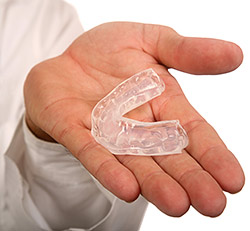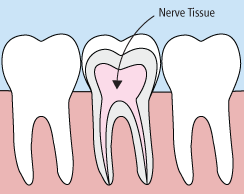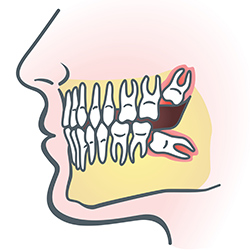Topics on this page

Regular Exams and Cleanings
Regular exams are an important part of maintaining your child's oral health. During your child’s regular exam, we will:
- Check for any problems that may not be seen or felt
- Look for cavities or any other signs of tooth decay
- Inspect the teeth and gums for gingivitis and signs of periodontal disease
- Take x-rays, if necessary and as recommended by dental guidelines
- Evaluate your child's occlusion and make any orthodontic recommendations
- Perform a thorough teeth cleaning and apply topical fluoride varnish
- Complete a caries risk assessment
- Review oral hygiene instructions and dietary recommendations
Each regular exam includes a detailed teeth cleaning and fluoride treatment, in which we will clean, polish, and rinse the teeth to remove any tartar and plaque that have built up on the tooth’s surface.
Visiting our office every six months gives you the chance to talk to the doctor about any questions you may have about your child’s oral health. Regular exams are offered by appointment only, so please contact our practice today to schedule your child’s next dental exam and teeth cleaning.
Bonding
 Bonding is a conservative way to repair slightly chipped, discolored, or crooked teeth. During dental bonding, a composite resin (tooth-colored or white filling) is placed onto your child's tooth to improve its appearance. The filling “bonds” with the tooth, and because it comes in a variety of tooth-colored shades, it closely matches the appearance of your child's natural teeth.
Bonding is a conservative way to repair slightly chipped, discolored, or crooked teeth. During dental bonding, a composite resin (tooth-colored or white filling) is placed onto your child's tooth to improve its appearance. The filling “bonds” with the tooth, and because it comes in a variety of tooth-colored shades, it closely matches the appearance of your child's natural teeth.
Tooth bonding can also be used for fillings instead of amalgam. Many patients prefer bonded fillings because the white color of the composite resin is much less noticeable than silver. Bonding fillings can be used on front or back teeth, depending on the location and extent of tooth decay.
Bonding is less expensive than other cosmetic treatments and can usually be completed in one visit to our office. However, bonding can stain and is easier to break than other cosmetic treatments, such as porcelain crowns and veneers. If it does break or chip, tell your doctor. The bonding can generally be easily repaired in one visit.
Crowns
 Crowns are a restorative procedure used to improve a tooth’s shape or to strengthen a tooth. Crowns are most often used for teeth that are broken, worn, or have portions destroyed by tooth decay.
Crowns are a restorative procedure used to improve a tooth’s shape or to strengthen a tooth. Crowns are most often used for teeth that are broken, worn, or have portions destroyed by tooth decay.
Crowns can be used not only to save the decayed tooth, but they can also help prevent the spread of decay and infection to other areas of the mouth or body. Crowns restore a tooth's shape, size, and function.
A crown is a “cap” cemented onto an existing tooth that usually covers the portion of the tooth above the gum line. In effect, the crown becomes the tooth’s new outer surface.
When a child has a large cavity in a primary “baby tooth”, there is often not enough tooth structure left to hold a filling in it. In those cases, a stainless steel crown is used. Stainless steel crowns also are used to repair broken or cracked teeth and teeth weakened by defects. These crowns cover the damaged tooth and provide protection and strength. Because they are pre-made, stainless steel crowns are placed in one appointment and can be easily adapted to the child’s tooth. When the child loses the baby tooth, the crown falls out with it. Baby teeth that have received nerve treatments (pulpotomies or pulpectomies) also need to be restored with stainless crowns.
Alternatively, we also offer crowns that are made of monolithic Zirconia, a ceramic material time-tested for its strength and durability in adult dentistry. It is free of all metals including nickel.
TOOTH-COLORED ZIRCONIA CROWNS
For the last 60 years, large cavities in baby teeth have been treated with stainless-steel crowns. Although they are an excellent restoration and last without question, many parents have concerns over the stigma when their children have silver teeth.
One option is a Zirconia crown. Instead of having to use metal to place a strong layer of protection over the tooth, a beautiful, high-strength ceramic material is used. It can be used on either front or back teeth, and the child can avoid silver teeth. Cavities may keep happening, but at least we have an option to restore your son or daughter’s sparkling, brilliant smiles.
Kinder Krowns® offer esthetics, durability, and biocompatibility that no other material on the market can offer. By choosing Zirconia Kinder Krowns, you can be confident that your child's esthetic restoration will not only provide unrivaled esthetics but will also hold up until the primary (baby) tooth exfoliates.
Extractions
 There are times when it is necessary to remove a tooth. Sometimes a baby tooth has misshapen or long roots that prevent it from falling out as it should, and the tooth must be removed to make way for the permanent tooth to erupt. At other times, a tooth may have so much decay that it puts the surrounding teeth at risk of decay, so the doctor may recommend its removal. Infection, orthodontic correction, or problems with a wisdom tooth can also require removal of a tooth.
There are times when it is necessary to remove a tooth. Sometimes a baby tooth has misshapen or long roots that prevent it from falling out as it should, and the tooth must be removed to make way for the permanent tooth to erupt. At other times, a tooth may have so much decay that it puts the surrounding teeth at risk of decay, so the doctor may recommend its removal. Infection, orthodontic correction, or problems with a wisdom tooth can also require removal of a tooth.
When it is determined that a tooth needs to be removed, your child’s dentist may extract the tooth during a regular checkup or may request another visit for this procedure. The root of each tooth is encased within the jawbone in a “tooth socket”, and the tooth is held in that socket by a ligament. In order to extract a tooth, the dentist must expand the socket and separate the tooth from the ligament holding it in place. While this procedure is typically very quick, it is important to share with the doctor any concerns or preferences for sedation.
Fillings
 Traditional dental restoratives, or fillings, are most often made of silver amalgam. The strength and durability of traditional dental materials continue to make them useful for situations where restored teeth must withstand extreme forces that result from chewing, such as in the back of the mouth.
Traditional dental restoratives, or fillings, are most often made of silver amalgam. The strength and durability of traditional dental materials continue to make them useful for situations where restored teeth must withstand extreme forces that result from chewing, such as in the back of the mouth.
Newer dental fillings include plastic compounds that mimic the appearance of natural teeth. These compounds, often called composite resins or tooth-colored fillings, are usually used on the front teeth where a natural appearance is important, as well as on the back teeth depending on the location and extent of the tooth decay. Composite resin actually bonds to enamel and dentin and strengthens the tooth while restoring it to its original shape. A more conservative tooth preparation is used during decay removal so less healthy tooth structure is lost which allows us to fix small cavities earlier, before large restorations are needed. Sealants can also be placed over small fillings on posterior (back) teeth to prevent further decay.
What’s right for your child?
Several factors influence the performance, durability, longevity and expense of dental restorations, including:
- The components used in the filling material
- The amount of tooth structure remaining
- Where and how the filling is placed
- The chewing load that the tooth will have to bear
- The length and number of visits needed to prepare and adjust the restored tooth
Dr. Merlo utilizes state-of-the-art technologies and techniques to correct tooth decay, and before your child’s treatment begins, she will discuss all options and help you choose the best filling for your child’s particular case.
Fluoride
 Fluoride is effective in preventing cavities and tooth decay and in preventing plaque from building up and hardening on the tooth’s surface. A fluoride treatment in a dentist’s office takes just a few minutes. After the treatment, your child may be asked not to rinse, eat, or drink for at least 30 minutes in order to allow the teeth to absorb the fluoride. Depending on your child’s oral health or the doctor’s recommendation, a fluoride treatment may be required every three, six, or 12 months.
Fluoride is effective in preventing cavities and tooth decay and in preventing plaque from building up and hardening on the tooth’s surface. A fluoride treatment in a dentist’s office takes just a few minutes. After the treatment, your child may be asked not to rinse, eat, or drink for at least 30 minutes in order to allow the teeth to absorb the fluoride. Depending on your child’s oral health or the doctor’s recommendation, a fluoride treatment may be required every three, six, or 12 months.
Mouthguards
 Whether your child wears braces or not, protecting his or her smile while playing sports is essential. Mouthguards help protect the teeth and gums from injury. If your child participates in any kind of full-contact sport, the American Dental Association recommends that he or she wear a mouthguard. Choosing the right mouthguard is essential. There are three basic types of mouthguards: the pre-made mouthguard, the “boil-and-bite” fitted mouthguard, and a custom-made mouthguard from the dentist. When you choose a mouthguard, be sure to pick one that is tear-resistant, comfortable and well-fitted for your mouth, easy to keep clean, and does not prevent your child from breathing properly. Your dentist can show your child how to wear a mouthguard properly and how to choose the right mouthguard to protect his or her smile.
Whether your child wears braces or not, protecting his or her smile while playing sports is essential. Mouthguards help protect the teeth and gums from injury. If your child participates in any kind of full-contact sport, the American Dental Association recommends that he or she wear a mouthguard. Choosing the right mouthguard is essential. There are three basic types of mouthguards: the pre-made mouthguard, the “boil-and-bite” fitted mouthguard, and a custom-made mouthguard from the dentist. When you choose a mouthguard, be sure to pick one that is tear-resistant, comfortable and well-fitted for your mouth, easy to keep clean, and does not prevent your child from breathing properly. Your dentist can show your child how to wear a mouthguard properly and how to choose the right mouthguard to protect his or her smile.
Nightguards
 If your child often wakes up with jaw pain, earaches, or headaches, or if you see your child clenching or grinding his or her teeth, your child may have a common condition called “bruxism”. Many people do not even know that they grind their teeth, as it often occurs when one is sleeping. If not corrected, bruxism can lead to broken teeth, cracked teeth, or even tooth loss.
If your child often wakes up with jaw pain, earaches, or headaches, or if you see your child clenching or grinding his or her teeth, your child may have a common condition called “bruxism”. Many people do not even know that they grind their teeth, as it often occurs when one is sleeping. If not corrected, bruxism can lead to broken teeth, cracked teeth, or even tooth loss.
There is an easy, non-invasive treatment for bruxism: nightguards. Nightguards are an easy way to prevent the wear and damage that teeth-grinding causes over time. Custom-made by a dentist from soft material to fit the teeth, a nightguard is inserted over your child’s top or bottom arch and prevents contact with the opposing teeth.
PULPOTOMY/PULPECTOMY
 If your child’s primary tooth has extensive decay, or has been damaged by trauma, action may be needed to restore the integrity of the tooth and prevent infection from spreading to surrounding teeth. After a set of X-rays are taken, your dentist will be able to assess the extent of the infection and recommend one of two options, a pulpotomy or a pulpectomy.
If your child’s primary tooth has extensive decay, or has been damaged by trauma, action may be needed to restore the integrity of the tooth and prevent infection from spreading to surrounding teeth. After a set of X-rays are taken, your dentist will be able to assess the extent of the infection and recommend one of two options, a pulpotomy or a pulpectomy.
PULPOTOMY
If the decay or trauma is confined to the crown of the tooth, a pulpotomy may be recommended. When a cavity gets really deep, close to the pulp of a tooth, or even into the pulp, the pulpal tissue becomes irritated and inflamed. A pulpotomy is when the inflamed pulp chamber, usually on a baby molar, is removed. The dentist will remove all the infected material in the pulp of the crown only, leaving the living tooth root intact. After a pulpotomy on a baby molar, the empty space will be filled with dental cement and a crown will be placed to restore the tooth.
PULPECTOMY
If the infection involves tissue in both the tooth crown and the tooth root, a pulpectomy may be the best option. In a pulpectomy, the entire pulp material is removed from both the crown and the roots. The dentist will remove the pulp and nerve tissue from the crown and from the canals of the roots. Then, the pulp chamber and root canals will be thoroughly cleaned and disinfected. Next, the dentist will fill the tooth and tooth roots with a dental cement, and finish with a stainless steel crown.
Root Canals
In the past, if your child had a permanent tooth with a diseased nerve, he or she would probably lose that tooth. Today, with a special dental procedure called “root canal treatment”, your child’s tooth can be saved. When a tooth is cracked or has a deep cavity, bacteria can enter the pulp tissue and germs can cause an infection inside the tooth. If left untreated, an abscess may form. If the infected tissue is not removed, pain and swelling can result. This can not only injure your child’s jawbones, but it is also detrimental to his or her overall health.
Root canal treatment involves one to three visits. During treatment, the dentist will remove the affected tissue. Next, the interior of the tooth will be cleaned and sealed. Finally, the tooth is filled with a dental composite. If the tooth has extensive decay, your doctor may suggest placing a crown to strengthen and protect the tooth from breaking. As long as your child continues to care for his or her teeth and gums with regular brushing, flossing, and checkups, the restored tooth can last a lifetime.
Sealants
 Sometimes brushing is not enough, especially when it comes to those hard-to-reach spots in your child’s mouth. It is difficult for a toothbrush to get in between the small cracks and grooves on your child’s teeth. If left alone, those tiny areas can develop tooth decay. Sealants give your child’s teeth extra protection against decay and help prevent cavities.
Sometimes brushing is not enough, especially when it comes to those hard-to-reach spots in your child’s mouth. It is difficult for a toothbrush to get in between the small cracks and grooves on your child’s teeth. If left alone, those tiny areas can develop tooth decay. Sealants give your child’s teeth extra protection against decay and help prevent cavities.
Dental sealants are a plastic resin that bonds and hardens in the deep grooves on your child’s tooth’s surface. When a tooth is sealed, the tiny grooves become smooth and are less likely to harbor plaque. With sealants, brushing your child's teeth becomes easier and more effective against tooth decay.
Sealants are typically applied to children’s teeth as a preventive measure against tooth decay after the permanent teeth have erupted. It is more common to seal “permanent” teeth rather than “baby” teeth, but every patient has unique needs, and your child’s dentist will recommend sealants on a case-by-case basis.
Sealants can last for several years, and it is fairly common to see adults with sealants still intact from childhood. A dental sealant only provides protection when it is fully intact. During your child’s regular dental visits, we will check the sealants for any cracks and chips and reseal them as needed.
Wisdom Teeth
 Wisdom teeth are types of molars found in the very back of your child’s mouth. These teeth usually appear in late teens or early 20s, but they may become impacted (fail to erupt) due to lack of room in the jaw or angle of entry. When a wisdom tooth is impacted, it may need to be removed. If it is not removed, your child may develop gum tenderness, swelling, or even severe pain. Impacted wisdom teeth that are partially or fully erupted tend to be quite difficult to clean and are susceptible to tooth decay, recurring infections, and even gum disease.
Wisdom teeth are types of molars found in the very back of your child’s mouth. These teeth usually appear in late teens or early 20s, but they may become impacted (fail to erupt) due to lack of room in the jaw or angle of entry. When a wisdom tooth is impacted, it may need to be removed. If it is not removed, your child may develop gum tenderness, swelling, or even severe pain. Impacted wisdom teeth that are partially or fully erupted tend to be quite difficult to clean and are susceptible to tooth decay, recurring infections, and even gum disease.
Wisdom teeth are typically removed in the late teens or early twenties because there is a greater chance that the tooth’s roots have not fully formed and the bone surrounding the teeth is less dense. These two factors can make extraction easier as well as shorten the recovery time.
Silver Diamine Fluoride (SDF)
Silver Diamine Fluoride (SDF) is an FDA-approved topical solution that treats and prevents dental caries and reduces tooth sensitivity. It is made with two acting ingredients: the silver component is an anti-microbial agent that kills bacteria and prevents the formation of new biofilm, and the fluoride prevents further demineralization (softening) of the tooth structure.
Treatment with SDF does not eliminate the need for restorative dentistry (fillings, crowns, etc.) to repair function or aesthetics, but is effective at preventing further decay.
SDF is a simple and noninvasive way to treat carious lesions (cavities), and it can be done from the comfort of our dental office.
- The teeth are brushed without paste and rinsed.
- The carious teeth are isolated, kept dry, and all excess debris is removed.
- A microbrush is dipped in a drop of SDF and placed on the lesion(s) for two minutes.
- Any decayed areas will stain black. Healthy tooth structure will not stain.
- Excess SDF is removed and patients are instructed to not eat or drink for one hour.
WHY USE SDF?
We recommend using SDF in several situations, including:
- Children who have extreme decay (severe early childhood caries)
- Young children who have difficulty sitting still for treatment
- Special needs patients
- Children with carious lesions (cavities) that need to be treated over several visits
THE ADVANTAGES OF SDF:
- Provides immediate relief from tooth hypersensitivity
- Kills the organisms that cause cavities
- Hardens softened dentin making it more acid- and abrasion-resistant
- Does not stain healthy dentin or enamel
